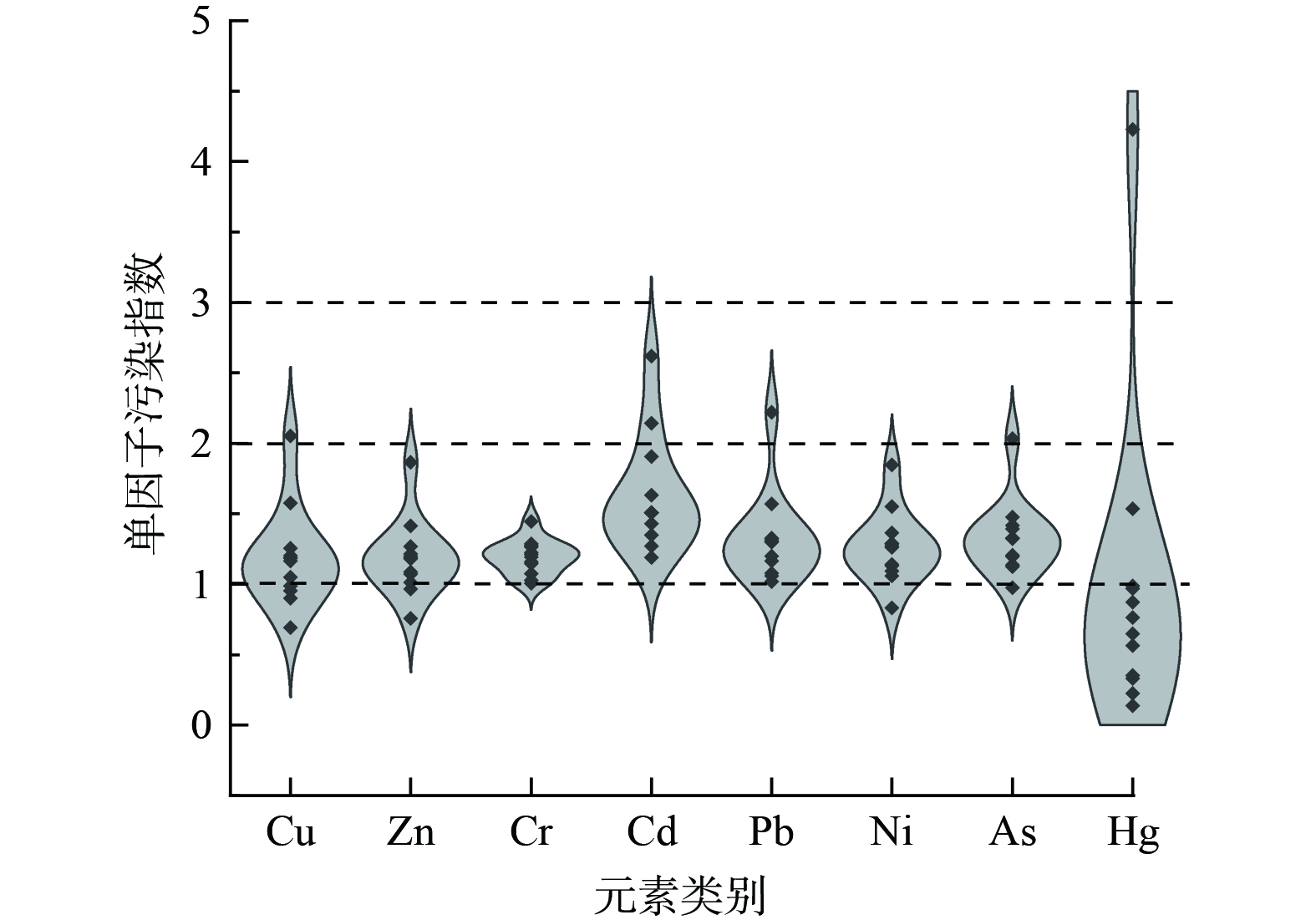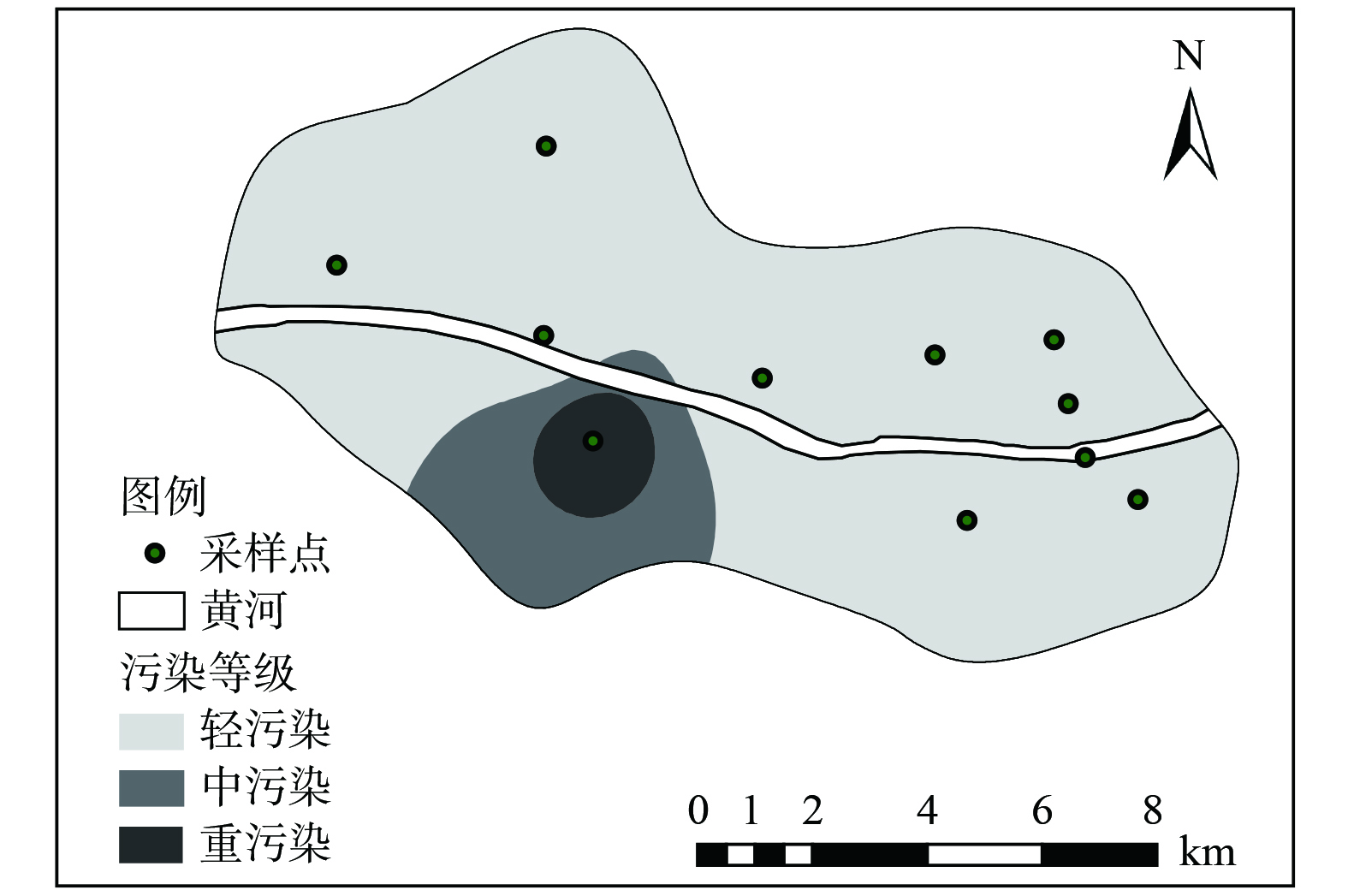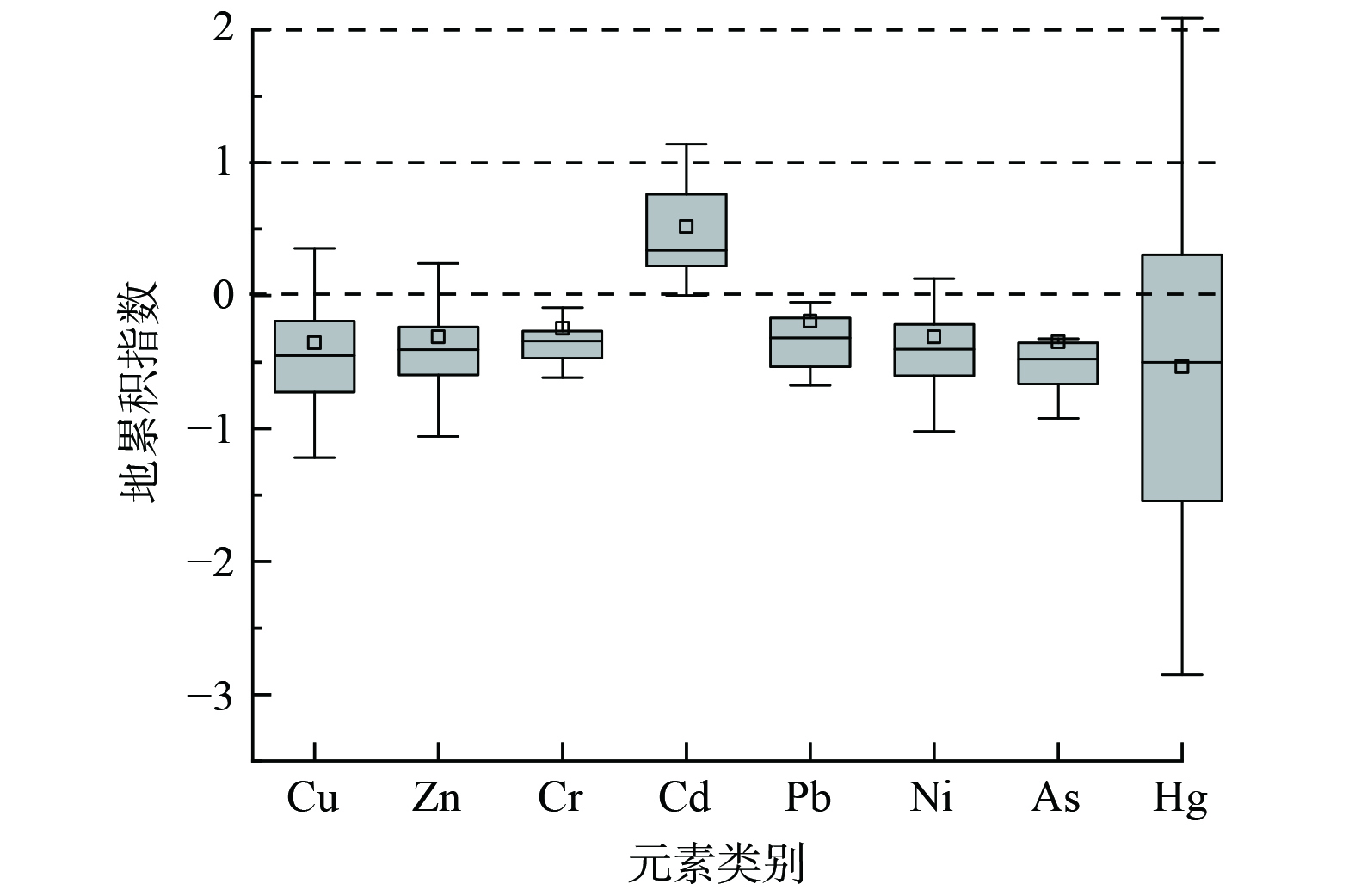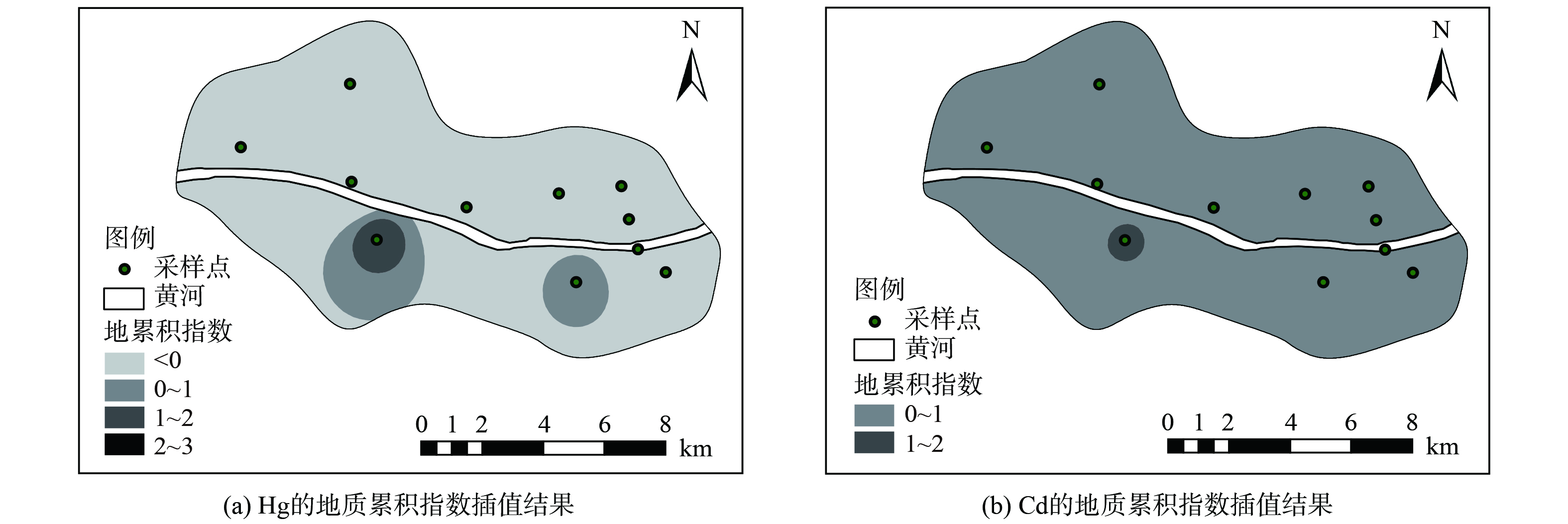-
黄河流域是我国经济发展的重要区域,也是我国重要的生态屏障。2019年,黄河流域生态保护和高质量发展上升为重大国家战略。2021年,国务院发布《黄河流域生态保护和高质量发展规划纲要》,其中,地处黄河入海口、位于山东省东营市内的黄河三角洲是黄河流域生态保护“一带五区多点”空间布局中“五区”之一的河口生态保护区。黄河三角洲是中国甚至世界暖温带唯一一块保存最完整、最典型、最年轻的湿地生态系统,是具有国际意义的重要保护湿地[1-2],又因其是众多珍稀濒危鸟类重要的繁殖地和迁徙中转站,被称为“鸟类的国际机场”,具有重要的生态意义[3]。为了保护黄河三角洲生态环境,国务院批准建立了黄河三角洲国家级自然保护区。该保护区由核心区、缓冲区、实验区3个不同的功能区组成。核心区是保护区内最核心、最重要的地段,亦是保护区内保存完好的天然状态的生态系统及珍稀、濒危动植物的集中分布地。该区域以保护种源为主,对生物多样性的保护起着至关重要的作用,区内严格禁止一切人为活动。实验区是黄河口生态旅游区的主体区域,可进入从事科学实验、参观考察、旅游及驯化、繁殖珍稀野生动植物等活动。缓冲区位于二者之间,主要起过渡和缓冲的作用[4]。
近年来,保护区不断受到油田开采、农业生产、水利工程等人类活动干扰[5- 6],已出现不同程度的重金属污染状况。如三角洲内黄河沿岸存在多处重金属高值点,且部分点位沉积物样品中重金属浓度超过土壤环境质量一级标准[7];保护区北部Pb、Cd的含量较高,部分点位也超出了中国土壤环境背景值[8]。李旭东等[9]指出黄河三角洲保护区中5.56%的区域的重金属生态风险为强生态风险。尽管该区域河口沉积物中Zn和Pb毒性效应很少发生,但Cd、Ni、Cr和Cu毒性效应会偶尔发生[10];且黄河三角洲湿地土壤中重金属主要在土壤表层0~20 cm处富集,重金属随着土壤深度的增加而减少[11]。
由于核心区严格限制人员活动,本课题组选取紧邻核心区的实验区湿地,对其重金属空间分布及污染情况进行研究。本研究探讨黄河三角洲分布于核心区附近的实验区表层沉积物中重(类)金属(Cu、Zn、Cr、Cd、Pb、Ni、As、Hg)的质量分数及其空间分布特征,采用内梅罗综合污染指数法、地累积指数法和潜在生态风险指数法对研究区域重金属污染状况进行综合评价,并对不同重金属元素的污染贡献进行比较分析。以期为黄河三角洲区域重金属污染的防治及湿地资源的合理开发利用提供参考。
-
黄河三角洲湿地位于黄河入海口,地处渤海湾南岸以及莱州湾西岸,主要分布在山东省东营市境内。位置为东经118°33'~119°20',北纬37°35'~38°12'。气候为温带大陆性季风气候,年平均气温12.6 ℃。年平均降水量592.2 mm,年平均蒸发量550 mm[12]。
采样时间为2020年11月。在黄河三角洲靠近核心区的实验区内,共设置了11个采样点(图1)。采集的沉积物样品(0~20 cm)使用冷冻干燥机冻干至恒重。沉积物使用研钵研磨后过150目尼龙筛备用。取0.25 g处理好的沉积物,按照《土壤和沉积物 金属元素总量的消解 微波消解法》(HJ832-2017)中的方法进行微波消解,消解液使用1%(质量分数)硝酸(所用硝酸为优级纯硝酸)定容,再过0.22 μm聚醚飒(Polyethersulfone,PES)膜后待测。
-
本研究中采集的7种重(类)金属(Cu、Zn、Cr、Cd、Pb、Ni、As)的质量分数使用电感耦合等离子体质谱仪(ICP-MS)(NexION 300X,Perkin Elmer,USA)进行检测,Hg的质量浓度采用测汞仪(HydraⅡ,USA)测定。在样品测试过程中,每10个样品加1个标准液进行回测进行校准曲线。使用水系沉积物标准物质GBW07309(GSD-9)做全程质量控制,以保证样品分析的精确性,所测的各种重金属元素的RSD≦5.0%,各重金属的回收率均在国家标准参比物质的允许范围内,结果准确可信。
-
数据采用SPSS 26.0软件对数据进行描述性统计;在ArcGIS 10.8软件的地统计学模块中,运用反距离权重插值法绘制表层沉积物重金属空间分布图。
-
1) 变异系数。变异系数是表征样品变异程度的重要尺度,能在一定程度上反映重金属含量受人为影响的程度[13],其计算公式为式(1)。
式中:CV为变异系数(Coefficient of variation);SD为标准偏差(Standard Deviation);MN为平均值(Mean)。变异系数随数据离散程度的增高而增大,变异系数<10%为轻度变异;10%<变异系数<100%,为中度变异;变异系数>100%,为强变异[14]。
2) 单因子污染指数法。土壤中某一重金属元素污染评价采用单因子污染指数法,其计算公式[15]如式(2)。
式中:Pi为土壤重金属元素i的环境质量指数;Ci为重金属元素i的实测值,mg·kg−1;C0i为重金属i的评价标准,mg·kg−1,本文选用东营市土壤背景值[16]。等级划分标准为:Pi≤1表示清洁,1<Pi≤2表示轻微污染,2<Pi≤3表示轻度污染,3<Pi≤5表示中度污染,Pi>5表示重度污染。
3) 内梅罗指数法。内梅罗指数法兼顾了单项污染指数平均值和最大值,突出了高浓度污染物对土壤环境质量的影响,是土壤重金属污染评价常用的方法,其计算公式[17]如式(3)。
式中:Ip为内梅罗指数;Ci为土壤重金属i的测定值,mg·kg−1;C0i为重金属i的土壤环境质量背景值值mg·kg−1,本文采用东营市土壤背景值。内梅罗指数法分级标准见表1[18]。
4) 地质累积指数法。地质累积指数法兼顾了自然地质演变过程对背景值的影响和人类活动对重金属污染的影响,是反映重金属分布的自然变化和判别人类活动对环境影响的重要方法,其计算公式[19]为式(4)。
式中:Igeo为地质累积指数;Ci为土壤重金属i的测定值,mg·kg−1;Bi为土壤重金属i的背景值,mg·kg−1,本文选用东营市土壤背景值为参照;K为无量纲变化系数,一般取K=1.5。地质累积指数法分级标准见表2[20]。
5) 潜在生态风险指数评价法。潜在生态风险指数评价法综合考虑了重金属毒性及污染行为等特点,是从沉积学角度提出的重金属污染评价方法,其计算公式[21]为式(5)。
式中:RI为潜在生态危害指数;Eir为潜在生态危害单项系数,无量纲;T ir为土壤重金属i的毒性系数,无量纲;Cir为土壤重金属i的污染系数,无量纲;Ci为土壤重金属i的测定值,mg·kg−1;Cin为土壤重金属i的评价标准值,mg·kg−1。本研究所选取的Cu、Zn、Cr、Cd、Pb、Ni、As和Hg的毒性系数分别为1、2、5、5、5、10、30、40。根据毒性系数之和(133)放大后确定RI的第1级阈值,其他各级依次扩大2倍;而本文毒性系数之和为98,故将本研究种的RI第1级阈值设置为110(见表3)。
-
黄河三角洲表层土壤重金属统计特征值如表4所示。与东营市土壤背景值相比,除Hg的平均质量分数在土壤背景值之下,其他重金属质量分数的平均值均超出背景值,这表明研究区可能已出现重金属富集现象。与国家土壤环境质量标准(GB 15618-1995)[22]相比,仅有Cd的平均值高于国家一级标准值,这表明研究区Cd平均质量分数已超出保护区域自然生态,维持自然背景的土壤环境质量的限制值,Cu、Zn、Cr、Pb、Ni、As和Hg的平均质量分数值均低于国家一级标准值。这表明这些元素在土壤中基本保持自然背景水平,符合国家规定的自然保护区生态安全保护标准。此外,Hg变异系数最高,为119%,属于强变异,其余各重金属变异系数均处于10%~100%,属于中度变异。这说明黄河三角洲河道沿岸表层沉积物中Hg受外界干扰比较显著,空间变异较大。
重金属空间分布(图2)表明,研究区表层沉积物重金属质量分数整体呈现南岸高于北岸的分布趋势,且自西向东重金属质量分数逐渐降低。这可能与海水的稀释及盐度的升高有关,随盐度升高,颗粒态重金属有向溶解态转移的趋势[23]。8种元素质量分数的最高值都出现在南岸1采样点处,该处Cu、Zn、Cr、Cd、Pb、Ni、As和Hg的质量分数分别是东营市土壤背景值的2.05、1.87、1.45、2.62、2.22、1.85、2.03和4.23倍。南岸1采样点与保护区的景点“鸟岛”距离较近。鸟岛是每年鸟类迁徙时集中休息和觅食的区域,也是保护区内在候鸟迁徙季节鸟类活动最集中的区域。本研究中的采样时间正值北方越冬候鸟大量南迁,大批候鸟集群组团降临三角洲。鸟类的迁徙往往形成较大的集群,数量庞大的候鸟群的取食和排泄活动对其所栖息的环境具有非常大的影响。匡盈等[24]以同里国家湿地公园为研究区,探讨鸟粪对河流底泥重金属全量及形态的影响,发现有鸟粪区域底泥的重金属质量分数及生态风险高于无鸟粪区域;西班牙的黄腿鸥和美国佛罗里达大沼泽湿地的鸟粪便沉积也会显著增加土壤当中的重金属含量[25-26]。因此,候鸟粪便的大量输入可能是此处重金属质量分数较高的重要原因。另外,Cd在北岸7采样点质量分数较高,可能与区内耕地面积大幅增加及频繁的农业活动有关[6, 27-28]。
-
1) 土壤综合污染指数评价。由单因子污染指数法计算单个重金属的污染情况,结果如图3所示。8种重金属的大多点位都处于清洁到轻微污染的水平,Cu、Cd、Pb和As在个别点位达到轻度污染水平,Hg元素在南岸1采样点达到中度污染水平。内梅罗综合污染指数结果见图4。研究区大部分区域属于轻污染,但南岸1采样点污染较为严重,达到中污染到重污染水平。南岸1采样点的严重污染极有可能会影响到邻近的核心区,应当引起重视。
2) 地质累积指数法。研究区表层沉积物重金属地累积指数评价结果见图5。8种元素Igeo平均值排序为: Cd>Pb>Cr>Zn>Ni>As>Cu>Hg。针对研究区整体而言,Cd污染程度为轻微污染,其他元素均无污染。对于单个重金属的地累积指数进行分析,发现Cr、Cu、Pb、Zn、Ni和As这6种重金属均处于无污染和轻度污染之间,而Cd大部分样品处于轻度污染及中度污染,Hg大部分样品属于无污染,但个别样品达到了中度到重度污染。因此,选取研究区内污染较严重的Cd和Hg 2种元素,对其地质累积指数进行反距离权重插值。由插值结果(图6)可知,研究区内Hg污染以西南部南岸1采样点附近最为严重,局部区域达到中度到重度污染。研究区Cd元素的污染程度相对较低但污染范围较广,大部分地区为轻微污染,局部区域出现了轻度污染。
3) 潜在生态风险指数评价法。表5表明研究区表层沉积物重金属潜在生态风险程度为Cd>Hg>As>Pb>Ni>Cu>Cr>Zn。综合各单项潜在生态风险指数的平均值发现,元素As、Cu、Pb、Ni、Cr和Zn均处于轻度生态危害程度,Cd和Hg为主要生态风险贡献因子,Cd在各个采样点的生态风险均较高,其中9个采样点处于中度生态危害及以上水平。而Hg在大部分采样点都处于轻度生态危害,但存在2个污染较重的采样点,分别处于中度生态危害和很强生态危害水平。土壤中的Hg来源可分为自然源和人为源。自然源来自成土母质及大气沉降,研究区的沉积物来源相同,且各个采样点距离较近,因此自然源不是Hg污染的主要因素。人为源主要包括工业生产废料和城市生活垃圾的堆放,农田耕作中不合理地施用含汞的肥料和农药以及污水灌溉等[29]。鸟岛是保护区内的重要景点,因此可排除工业废料、城市垃圾及污水灌溉等人为污染源。但该处园区内有大片湖泊供候鸟休息觅食,结合前文分析可知,鸟类粪便会增加其所栖息环境的土壤重金属含量,故该区域的Hg污染可能与此处数量庞大的候鸟群的取食和排泄活动有关。从综合潜在生态风险角度分析,研究区RI为71.66~303.34,平均值为123.32,属于轻微-中等生态危害,但南岸1采样点的综合潜在生态风险达到强生态危害,应加强对此处重金属污染的控制,防止其对核心区的生态环境产生不利影响。
-
1) 轻污染等级区域的修复措施。研究结果表明,黄河三角洲实验区内大部分区域重金属污染均处于轻污染等级区域,针对这些区域应采取预防为主的保护策略。具体措施有:①对实验区重金属浓度进行实时监控,以维持当前较好的沉积物环境状况;②加强对进入保护区的黄河水的监测,防止上游工业、农业、畜牧业和居民生活中产生的大量污染物通过河流进入保护区;③严格限制区内的各种人类活动干扰,如石油开采、农业活动、旅游观光等。
2) 对Cd的防控及修复措施。Cd是黄河三角洲实验区的主要生态风险贡献因子之一,而Cd通常被认为是农业活动的一种标志性元素[27]。一些磷肥、复合肥、水溶性肥均有Cd超标现象,特别是磷肥会加重土壤中Cd的含量,因此可以通过精准施肥技术、施用新型肥料等方式来减少实验区内磷肥的施用[30-31]。对于已遭受Cd污染的土壤,建议采取植物修复与添加螯合剂相结合的方式进行修复。研究区内中轻度Cd污染土壤可通过植物吸取技术实现修复[32]。此外,通过施用土壤改良剂或重金属钝化剂,可有效降低重金属Cd在土壤中的生物有效性和迁移性。
3) 加强Hg的溯源及修复。研究区内Hg质量分数分布极不均匀,南岸1采样点Hg质量分数较高,达中等生态风险,其余采样点均处于轻微生态风险。土壤环境Hg污染具有多源性、持续性、隐蔽性等特点,因此应对现有Hg污染场地进行全面调查,查明并切断污染源,并做好Hg质量分数的长期监测工作。目前,Hg的修复治理技术主要有热脱附技术、固化/稳定化技术和植物修复技术。鉴于研究区与核心区距离较近,采用植物修复方法更为安全且环境友好。芦苇和红树对土壤中Hg的吸收及储存能力均较强[33],且均为耐盐碱植物,建议在采样点南岸1附近增加此类植物的种植数量来降低该处的Hg污染。
-
1) 黄河三角洲河道沿岸表层沉积物中Cu、Zn、Cr、Cd、Pb、Ni、As和Hg的平均质量分数分别为24.87、73.75、78.16、0.21、25.66、34.66、13.68和0.02 mg·kg−1;南岸1采样点的8种重金属质量分数均明显高于其它采样点,且均高于东营市土壤背景值,超出范围达1.45~4.23倍。分析样品的变异系数发现,Hg属于强变异,受外界干扰较大,其余7种重金属均属于中度变异。
2) 黄河三角洲表层沉积物中8种重金属空间分布特征大体一致,均呈现南岸质量分数高于北岸的分布规律,且质量分数最高值均位于南岸1采样点处。可能是由于候鸟迁徙季节鸟类粪便的大量输入导致土壤重金属含量的升高。北岸区域虽分布有较多油田,但总体来说重金属含量低于南岸。这表明近年来黄河三角洲自然保护区所采取的一系列控制石油开采、保护生态环境的工作卓有成效,但区内农业活动造成的污染应当引起重视。
3) 内梅罗综合污染指数显示各个采样点均存在不同程度的污染,其中南岸1采样点污染最为严重,达到重污染等级,其余采样点均处于轻污染等级。依据潜在生态风险指数评价法分析各重金属单项潜在生态风险指数,风险顺序为Cd>Hg>As>Pb>Ni>Cu>Cr>Zn。从综合潜在生态风险角度分析,研究区RI介于71.66~303.34,平均值为123.32,属于轻微-中等生态危害。综合各单项潜在生态风险指数的平均值发现,Cd和Hg为主要生态风险贡献因子。针对污染较轻的区域采取预防为主的防控策略,同时加强区内的Cd和Hg的监测及修复。
黄河三角洲实验区表层沉积物重金属污染特征及防控策略
Characteristics and control strategies of heavy metal pollution in surface sediments of the Yellow River Delta experimental zone
-
摘要: 分析了黄河三角洲实验区内表层沉积物中重金属的空间分布特征,评价了其污染状况和生态风险,并根据评价结果提出了相应的重金属污染防控措施。结果表明:表层沉积物(0~20 cm)中Cu、Zn、Cr、Cd、Pb、Ni、As和Hg的平均质量分数分别为24.87,73.75,78.16,0.21,25.66,34.66,13.68,0.02 mg·kg−1;各重金属均呈现南岸高于北岸的空间分布特征,且所有元素质量分数的最高值均出现在景区“鸟岛”处;内梅罗综合污染指数分析表明,鸟岛属于中污染到重污染,其余采样点均为轻污染;地累积指数评价表明沉积物中Cd和Hg污染相对严重;潜在生态风险指数表明研究区总体属于轻微-中等生态危害。黄河三角洲邻近核心区的实验区表层沉积物中重金属综合污染程度较低,但存在局部污染较重的区域,Cd和Hg是主要的潜在生态风险因子。基于以上研究结果,建议针对黄河三角洲实验区采取预防为主的防控策略,同时应加强区内Cd和Hg的监测并适时开展修复工作。Abstract: This study was to investigate the spatial distribution characteristics for the selected heavy metals in surface sediments from the experimental zone of the Yellow River delta and evaluate their pollution condition and ecological risks. The results showed that the average concentration of Cu, Zn, Cr, Cd, Pb, Ni, As, and Hg in surface sediments (0~20 cm) were 24.87, 73.75, 78.16, 0.21, 25.66, 34.66, 13.68, and 0.02 mg·kg−1, respectively. The contents of selected heavy metals were higher in the surface sediment from the south bank than that from the north bank, while the maximum contents of metals were observed at scenic spot “Bird Island” located on the south bank. According to the analysis of the Nemerow Integrated Pollution Index (IPI), Bird Island was classified as being in the range of moderate to heavy pollution, while the rest of the sampling points were classified as light pollution. In addition, the Ground Accumulation Index (GAI) indicated that Cd and Hg contamination in the surface sediments were relatively serve. The Potential Ecological Risk Index (PERI) implied that the overall ecological hazard in the study area was categorized as slight to moderate. In summary, the pollution of heavy metals in surface sediments from the experimental zone of the Yellow River Delta was relatively low. However, Cd and Hg were the main potential ecological risk factors in the specific site with intensive heavy metal pollution. Based on the above findings, this study suggested that the prevention strategy should be adopted in the experimental area of Yellow River Delta, and the prevention, control and restoration of Cd and Hg should be strengthened.
-

-
表 1 内梅罗指数分级标准
Table 1. Grading standard of Nemerow index
污染指数 分级 污染程度 Ip≤1 Ⅰ 尚清洁 1<Ip≤2 Ⅱ 轻度污染 2<Ip≤3 Ⅲ 中度污染 Ip>3 Ⅳ 重度污染 表 2 地质累积指数分级标准
Table 2. Grading standard of geological accumulation index
等级 I geo 污染程度 0 I geo≤0 无污染 1 0<I geo≤1 轻度到中度污染 2 1<I geo≤2 中度污染 3 2<I geo≤3 中度污染到重度污染 4 3<I geo≤4 重度污染 5 4<I geo≤5 重度污染到极重污染 6 I geo>5 极重污染 表 3 潜在生态风险评价分级标准
Table 3. Classification criteria for potential ecological risk assessment
潜在生态危害单项系数 潜在生态危害指数 污染程度 Eir≤40 RI≤110 轻微生态危害 40< Eir≤80 110<RI≤220 中等生态危害 80< Eir≤160 220<RI≤440 强生态危害 160< Eir≤320 440<RI 很强生态危害 320< Eir — 极强生态危害 表 4 黄河三角洲表层土壤重金属统计特征值(n=11)
Table 4. Statistical characteristic values of heavy metals in the surface soil of the Yellow River Delta (n=11)
mg·kg−1 元素 最小值 最大值 平均值 变异系数 东营市背景值 国家一级标准值 Cu 14.52 43.10 24.87±7.70 30.97% 21.00 35.00 Zn 47.12 116.12 73.75±17.68 23.98% 62.20 100.00 Cr 65.87 94.73 78.16±8.42 10.77% 65.50 90.00 Cd 0.15 0.33 0.21±0.05 26.15% 0.13 0.20 Pb 19.74 43.05 25.66±6.51 25.38% 19.40 35.00 Ni 22.90 50.75 34.66±7.39 21.32% 27.50 40.00 As 10.04 20.95 13.68±2.85 20.86% 10.30 15.00 Hg 0.00 0.09 0.02±0.03 119.20% 0.02 0.15 表 5 沉积物单项潜在生态风险指数与综合潜在生态风险指数
Table 5. Sediment single potential ecological risk index and comprehensive potential ecological risk index
项目 Cu Zn Cr Cd Pb Ni As Hg RI 南岸1 10.26 1.87 2.89 78.57 11.10 9.23 20.34 169.09 303.34 南岸2 7.87 1.42 2.55 57.14 7.85 7.76 14.78 61.45 160.81 南岸3 5.94 1.18 2.29 42.86 6.52 6.43 13.93 34.93 114.09 入海口 4.77 1.07 2.01 45.24 5.82 5.65 11.26 22.63 98.45 北岸1 6.01 1.20 2.32 45.24 6.64 6.36 13.28 39.52 120.57 北岸2 4.50 0.96 2.53 45.24 6.49 5.29 11.36 25.88 102.26 北岸3 5.26 1.09 2.06 35.71 5.39 5.71 13.25 13.19 81.65 北岸4 4.95 1.01 2.15 38.10 5.30 5.47 12.05 8.98 78.01 北岸5 3.46 0.76 2.45 40.48 5.09 4.16 9.75 5.52 71.66 北岸6 6.28 1.27 2.58 45.24 6.56 6.82 11.96 30.53 111.23 北岸7 5.83 1.21 2.42 64.29 6.00 6.44 14.17 14.10 114.46 平均值 5.92 1.19 2.39 48.92 6.61 6.30 13.28 38.71 123.32 -
[1] 齐月, 李俊生, 马艺文, 等. 黄河三角洲滨海滩涂湿地沉积物重金属空间分布及生态风险评价[J]. 环境科学研究, 2020, 33(6): 1488-1496. [2] 宋颖, 李华栋, 时文博, 等. 黄河三角洲湿地重金属污染生态风险评价[J]. 环境保护科学, 2018, 44(5): 118-122. [3] 郑培明, 张春雨, 王安东, 等. 黄河三角洲河海陆交汇的年轻土地[J]. 森林与人类, 2022(1): 66-85. [4] GE M, LIU G, LIU H, et al. The distributions, contamination status, and health risk assessments of mercury and arsenic in the soils from the Yellow River Delta of China[J]. Environmental Science and Pollution Research, 2019, 26(34): 35094-35106. doi: 10.1007/s11356-019-06435-w [5] 任增颖. “生态旅游”是保护湿地?——2012年5月黄河三角洲国家级自然保护区生态调查[J]. 环境教育, 2012(8): 59-63. [6] 孔梅, 曹惠明, 高兴国, 等. 黄河三角洲自然保护区国土空间变化遥感监测与评价[J]. 海洋环境科学, 2021, 40(2): 272-276. [7] 缪雄谊, 叶思源, 郝玉培, 等. 黄河三角洲表层土壤重金属环境质量评价[J]. 海洋科学, 2016, 40(2): 65-76. [8] 刘淑民, 姚庆祯, 刘月良, 等. 黄河口湿地表层沉积物中重金属的分布特征及其影响因素[J]. 中国环境科学, 2012, 32(9): 1625-1631. [9] CHENG Q, ZHOU W, ZHANG J, et al. Spatial variations of arsenic and heavy metal pollutants before and after the water-sediment regulation in the wetland sediments of the Yellow River Estuary, China[J]. Marine Pollution Bulletin, 2019, 145: 138-147. doi: 10.1016/j.marpolbul.2019.05.032 [10] 黎静, 孙志高, 孙万龙, 等. 黄河尾闾河段和河口区沉积物中重金属污染及潜在生态毒性风险评价[J]. 湿地科学, 2018, 16(3): 407-416. [11] 李晓. 黄河口湿地土壤重金属分布及其形态对水盐的响应机制[Z]. 烟台: 鲁东大学, 2020. [12] 侯学会, 李新华. 黄河三角洲自然保护区1992~2010年土地覆被变化分析[J]. 亚热带植物科学, 2015, 44(4): 309-314. [13] 谢小进, 康建成, 李卫江, 等. 上海宝山区农用土壤重金属分布与来源分析[J]. 环境科学, 2010, 31(3): 768-774. [14] 李有文, 曹春, 巨天珍, 等. 白银市不同区域蔬菜地土壤重金属污染特征及生态风险评价[J]. 生态学杂志, 2015, 34(11): 3205-3213. [15] 孙文惠. 呼和浩特市不同功能区土壤重金属污染特征及评价研究[D]. 呼和浩特: 内蒙古大学, 2012. [16] 庞绪贵, 代杰瑞, 陈磊, 等. 山东省17市土壤地球化学背景值[J]. 山东国土资源, 2019, 35(1): 46-56. [17] 刘春早, 黄益宗, 雷鸣, 等. 湘江流域土壤重金属污染及其生态环境风险评价[J]. 环境科学, 2012, 33(1): 260-265. [18] 张鹏岩, 秦明周, 陈龙, 等. 黄河下游滩区开封段土壤重金属分布特征及其潜在风险评价[J]. 环境科学, 2013, 34(9): 3654-3662. [19] 闫晓露, 郑欢, 赵烜杭, 等. 辽东湾北部河口区土壤重金属污染源识别及健康风险评价[J]. 环境科学学报, 2020, 40(8): 3028-3039. [20] 张倩, 陈宗娟, 彭昌盛, 等. 大港工业区土壤重金属污染及生态风险评价[J]. 环境科学, 2015, 36(11): 4232-4240. [21] 徐争启, 倪师军, 庹先国, 等. 潜在生态危害指数法评价中重金属毒性系数计算[J]. 环境科学与技术, 2008(2): 112-115. [22] 国家环境保护局. GB15618-1995土壤环境质量标准[J]. 北京: 中国标准出版社, 1995. [23] XIE Z, ZHAO G, SUN Z, et al. Comparison of arsenic and heavy metals contamination between existing wetlands and wetlands created by river diversion in the Yellow River estuary, China[J]. Environmental Earth Sciences, 2014, 72(5): 1667-1681. doi: 10.1007/s12665-014-3071-6 [24] 匡盈, 方凤满, 姚有如, 等. 鸟粪对同里湿地底泥重金属含量分布及形态影响[J]. 长江流域资源与环境, 2018, 27(8): 1793-1799. [25] ZHU Y, GU B, IRICK D L, et al. Wading bird guano contributes to Hg accumulation in tree island soils in the Florida Everglades[J]. Environmental Pollution, 2014, 184: 313-319. doi: 10.1016/j.envpol.2013.08.037 [26] DE LA PEÑA-LASTRA S, PÉREZ-ALBERTI A, OTERO X L. Enrichment of trace elements in colonies of the yellow-legged gull (Larus michahellis) in the Atlantic Islands National Park (Galicia-NW Spain)[J]. Science of The Total Environment, 2019, 648: 1536-1548. doi: 10.1016/j.scitotenv.2018.08.284 [27] El AZZI D, PROBST J L, TEISSERENC R, et al. Trace element and pesticide dynamics during a flood event in the save agricultural watershed: soil-river transfer pathways and controlling factors[J]. Water, Air, & Soil Pollution, 2016, 227(12): 442. [28] SUN C, LIU J, WANG Y, et al. Multivariate and geostatistical analyses of the spatial distribution and sources of heavy metals in agricultural soil in Dehui, Northeast China[J]. Chemosphere, 2013, 92(5): 517-523. doi: 10.1016/j.chemosphere.2013.02.063 [29] 戴前进, 冯新斌, 唐桂萍. 土壤汞的地球化学行为及其污染的防治对策[J]. 地质地球化学, 2002, 30(4): 75-79. [30] 袁巧丽, 吕桂军, 安凤秋, 等. 开封市农田土壤重金属镉污染防控措施及修复技术浅析[J]. 黄河水利职业技术学院学报, 2020, 32(2): 50-54. [31] 孙丽娟, 秦秦, 宋科, 等. 镉污染农田土壤修复技术及安全利用方法研究进展[J]. 生态环境学报, 2018, 27(7): 1377-1386. [32] 胡鹏杰, 李柱, 吴龙华. 我国农田土壤重金属污染修复技术、问题及对策诌议[J]. 农业现代化研究, 2018, 39(4): 535-542. [33] 王荔娟, 胡恭任. 土壤/沉积物中汞污染地球化学及污染防治措施研究[J]. 岩石矿物学杂志, 2007, 26(5): 453-461. -



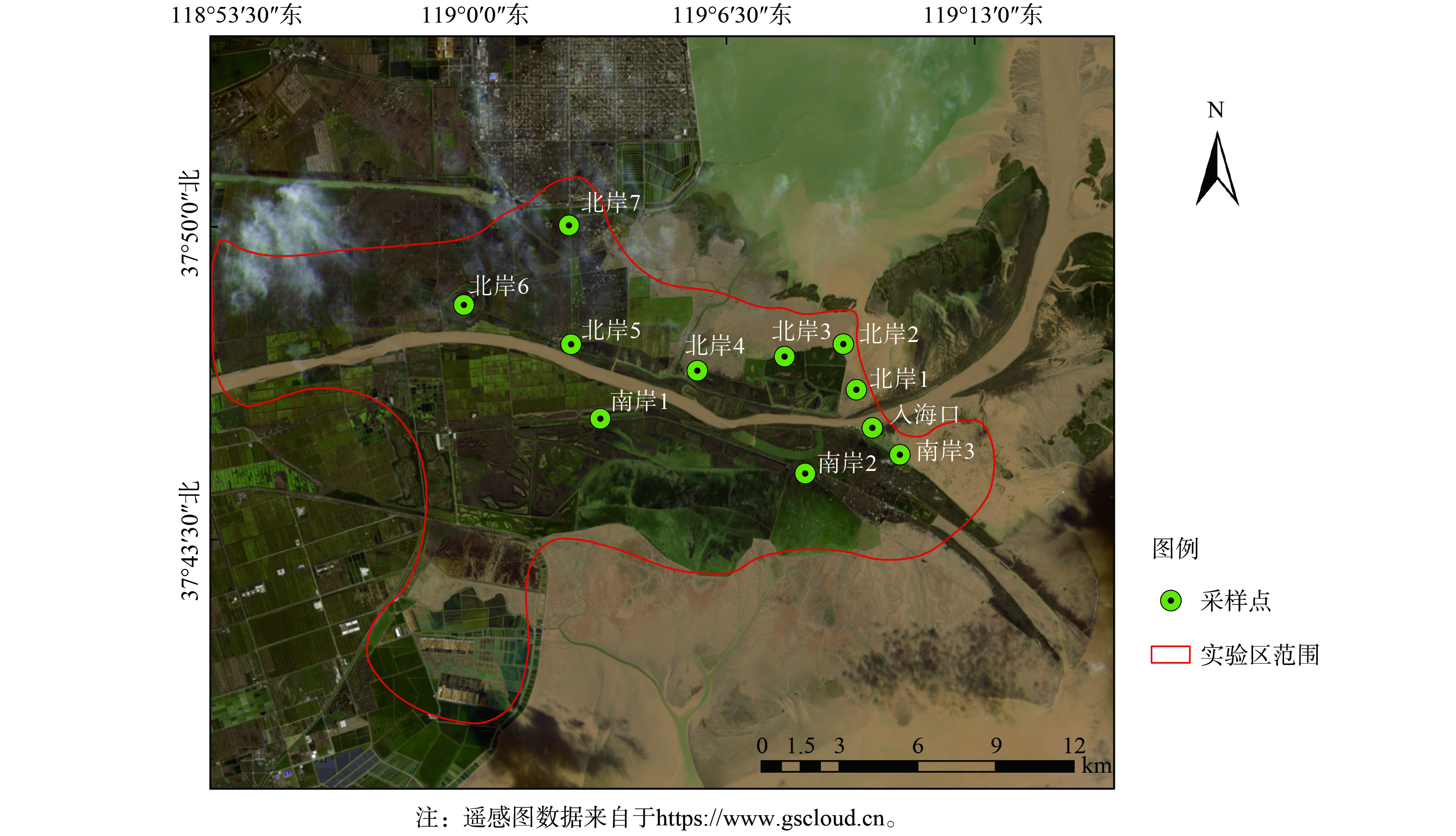
 下载:
下载:

